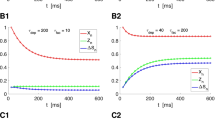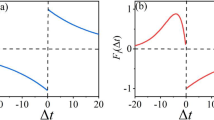Abstract.
Some synapses between cortical pyramidal neurons exhibit a rapid depression of excitatory postsynaptic potentials for successive presynaptic spikes. Since depressing synapses do not transmit information on sustained presynaptic firing rates, it has been speculated that they are favorable for temporal coding. In this paper, we study the dynamical effects of depressing synapses on stimulus-induced transient synchronization in a simple network of inhibitory interneurons and excitatory neurons, assuming that the recurrent excitation is mediated by depressing synapses. This synchronization occurs in a temporal pattern which depends on a given stimulus. Since the presence of noise is always a potential hazard in temporal coding, we investigate the extent to which noise in stimuli influences the synchronization phenomena. It is demonstrated that depressing synapses greatly contribute to suppressing the influences of noise on the stimulus-specific temporal patterns of synchronous firing. The timing-based Hebbian learning revealed by physiological experiments is shown to stabilize the temporal patterns in cooperation with synaptic depression. Thus, the times at which synchronous firing occurs provides a reliable information representation in the presence of synaptic depression.
Similar content being viewed by others
Author information
Authors and Affiliations
Additional information
Received: 5 July 2000 / Accepted in revised form: 12 January 2001
Rights and permissions
About this article
Cite this article
Fukai, T., Kanemura, S. Noise-tolerant stimulus discrimination by synchronization with depressing synapses. Biol Cybern 85, 107–116 (2001). https://doi.org/10.1007/PL00007998
Issue Date:
DOI: https://doi.org/10.1007/PL00007998




